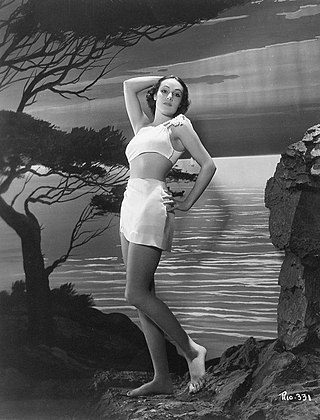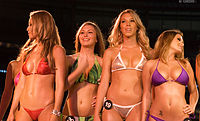
A bikini is a two-piece swimsuit primarily worn by girls and women that features one piece on top that covers the breasts, and a second piece on the bottom: the front covering the pelvis but usually exposing the navel, and the back generally covering the intergluteal cleft and a little, some, or all of the buttocks. The size of the top and bottom can vary, from bikinis that offer full coverage of the breasts, pelvis, and buttocks, to more revealing designs with a thong or G-string bottom that covers only the mons pubis, but exposes the buttocks, and a top that covers only the areolae. Bikini bottoms covering about half the buttocks may be described as "Brazilian-cut".

A beauty pageant is a competition that has traditionally focused on judging and ranking the physical attributes of the contestants. Pageants have now evolved to include inner beauty, with criteria covering judging of personality, intelligence, talent, character, and charitable involvement, through private interviews with judges and answers to public on-stage questions. The term beauty pageant refers originally to the Big Four international beauty pageants.

Miss World is the oldest existing international beauty pageant. It was created in the United Kingdom by Eric Morley in 1951. Since his death in 2000, Morley's widow, Julia Morley, has co-chaired the pageant. Along with Miss Universe, Miss International, and Miss Earth, it is one of the Big Four beauty pageants.

A swimsuit is an item of clothing designed to be worn by people engaging in a water-based activity or water sports, such as swimming, diving and surfing, or sun-orientated activities, such as sun bathing. Different types may be worn by men, women, and children. A swimsuit can be described by various names, some of which are used only in particular locations or for particular types of suit, including swimwear, bathing suit, bathing attire, swimming costume, bathing costume, swimming suit, swimmers, swimming togs, bathers, cossie, or swimming trunks, besides others.

Miss Earth is an annual international major beauty pageant based in the Philippines that advocates for environmental awareness, conservation and social responsibility. Along with Miss World, Miss Universe, and Miss International, it is one of the Big Four beauty pageants.

Kerstin Margareta "Kiki" Håkansson (1929–2011) was a Swedish model and beauty queen who was the first winner of the Miss World beauty pageant after being crowned Miss Sweden World in 1951.

Vida Samadzai is an Afghan-American actress, model and beauty pageant titleholder who was Miss Afghanistan 2003. As the first Afghan woman to participate in an international beauty pageant since 1974, her appearance in a red bikini in the 2003 edition of Miss Earth pageant created controversy in her native country. She was a contestant on the popular reality show Bigg Boss in 2011.
Hawaiian Tropic is an American brand of suntan lotion that was founded by Ron Rice in 1969. Hawaiian Tropic became the largest private manufacturer of sun care products in the United States. The company was acquired by Playtex Products, Inc. in May 2007. With Hawaiian Tropic and Playtex's Banana Boat brand, Playtex became the largest manufacturer of sun care products in the Western Hemisphere. Shortly after purchasing Hawaiian Tropic, Playtex Products was purchased by Energizer Holdings Inc. in a deal valued at $1.9 billion.

Fitness and figure competition is a class of physique-exhibition events mainly for women but also men. While bearing a close resemblance to bodybuilding, its emphasis is on muscle definition, not size. The class was introduced when bodybuilding's popularity began to decline.
Miss Earth 2003, the 3rd edition of the Miss Earth pageant, was held on November 9, 2003, at the University of the Philippines Theater in Quezon City, Philippines. Fifty-seven delegates from all over the globe participated in the event. The pageant was broadcast live via ABS-CBN in the Philippines and to many countries worldwide via Star World, The Filipino Channel and other partner networks. Winfred Omwakwe from Kenya crowned her successor Dania Prince of Honduras the end of the event. Brazil's Pricila Zandona was selected Miss Air 2003, Costa Rica's Marianela Zeledon Bolanos was chosen Miss Water 2003, and Poland's Marta Matyjasik was Miss Fire 2003. The pageant was hosted by Television show host Ariel Ureta. The candidates were initially presented at the poolside of Hotel Intercontinental Manila in Makati on October 22, 2003.

Miss Universe 1959 was the eighth Miss Universe pageant, held at the Long Beach Municipal Auditorium in Long Beach, California, United States on 24 July 1959. This was the last year that the pageant was held in Long Beach before it moved to Miami Beach, Florida in 1960.

Beauty for a Cause is the slogan of the Miss Earth beauty pageant which highlights the work of the pageant and the slogan was adopted since the pageant's inception in 2001. The slogan empowers the contestants to work with an environmental advocacy that is personally significant to them. The phrase is also the name of an award also given by the pageant. The first Beauty for a Cause prize was awarded in 2003.
Miss Nigeria is an annual pageant showcasing positive attributes of Nigerian women, and awarding university scholarships. The winner emerges winner portrays exemplary qualities and serves as a role model for young women in the country. The pageant is currently organised by Daily Times.

Miss World 1951 was the first Miss World pageant, held at the Lyceum Ballroom in London, United Kingdom on 29 July 1951. The contest was originally intended to be a one-off event connected with the Festival of Britain.
The Miss Universe Ireland is a national beauty pageant that has selected Ireland's representative to the Miss Universe pageant since 2002.

The modern bikini first appeared in 1946, and since then it has become a part of popular culture. It is one of the most widely worn women's swimsuits, used for swimming and in a variety of other contexts. Today, bikinis appear in competitions, films, magazines, music, literature, and video games. Despite the availability of more revealing glamour wear, bikini modeling remains popular and can still create controversy. Portrayals of the bikini in popular culture led, to a large extent, to its acceptance by Western society at large. In 1960, Brian Hyland's pop song "Itsy Bitsy Teenie Weenie Yellow Polkadot Bikini" inspired a bikini-buying spree. The white bikini worn by Ursula Andress as Honey Ryder in the 1962 James Bond film Dr. No has been cited as one of the most famous bikinis of all time. By 1963, the movie Beach Party, starring Annette Funicello and Frankie Avalon, led a wave of films that made the bikini a pop-culture symbol. Playboy first featured a bikini on its cover in 1962. The Sports Illustrated Swimsuit Issue debuted two years later. This increasing popularity was reinforced by its appearance in such contemporary films as How to Stuff a Wild Bikini featuring Annette Funicello and One Million Years B.C. (1966) featuring Raquel Welch. Raquel Welch's fur bikini in One Million Years B.C. became a famous moment in cinema history. Hollywood stars such as Marilyn Monroe, Jayne Mansfield, Gina Lollobrigida and Jane Russell further helped the growing popularity of bikinis. Pin up posters of Monroe and Mansfield, as well as Hayworth, Bardot and Raquel Welch distributed around the world contributed significantly to the popularity of the bikini.
Miss Pakistan World is a beauty pageant for women of Pakistani descent from around the world. The event used to be held in Toronto, Canada but has moved to Pakistan and is held annually in Lahore, Pakistan.
Magyarország Szépe is a national Beauty pageant for Miss World pageant. The pageant under the management of The Magyarország Szépe Kft. This pageant is not related to Miss Universe Hungary or Miss International Hungary contests.

There are a number of Iraqi beauty pageants. Miss Iraq is one of the national beauty pageants in Iraq. Others include Miss World Iraq and Miss Earth Iraq.

Eileen Mary O'Donnell, known professionally as Eileen O'Donnell, is a Northern Irish model and beauty pageant titleholder. O'Donnell started her career in 2011 and has since modelled in the categories of fashion, skincare and swimwear. She has gone on to collaborate with numerous notable brands including Pretty Little Thing, GymKing, MVMT Watches, The Couture Club, Ziaja Skincare, Benefit Cosmetics, amongst others.





















